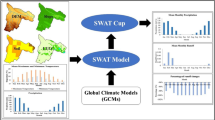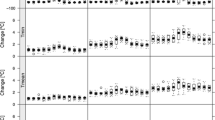Abstract
Particular attention is given to the reliability of hydrological modelling results. The accuracy of river runoff projection depends on the selected set of hydrological model parameters, emission scenario and global climate model. The aim of this article is to estimate the uncertainty of hydrological model parameters, to perform sensitivity analysis of the runoff projections, as well as the contribution analysis of uncertainty sources (model parameters, emission scenarios and global climate models) in forecasting Lithuanian river runoff. The impact of model parameters on the runoff modelling results was estimated using a sensitivity analysis for the selected hydrological periods (spring flood, winter and autumn flash floods, and low water). During spring flood the results of runoff modelling depended on the calibration parameters that describe snowmelt and soil moisture storage, while during the low water period—the parameter that determines river underground feeding was the most important. The estimation of climate change impact on hydrological processes in the Merkys and Neris river basins was accomplished through the combination of results from A1B, A2 and B1 emission scenarios and global climate models (ECHAM5 and HadCM3). The runoff projections of the thirty-year periods (2011–2040, 2041–2070, 2071–2100) were conducted applying the HBV software. The uncertainties introduced by hydrological model parameters, emission scenarios and global climate models were presented according to the magnitude of the expected changes in Lithuanian rivers runoff. The emission scenarios had much greater influence on the runoff projection than the global climate models. The hydrological model parameters had less impact on the reliability of the modelling results.









Similar content being viewed by others
References
Apel H, Thieken AH, Merz B, Bloschl G (2004) Flood risk assessment and associated uncertainty. Nat Hazards Earth Syst Sci 4:295–308. doi:10.5194/nhess-4-295-2004
Arduino G, Reggiani P, Todini E (2005) Recent advances in flood forecasting and flood risk assessment. Hydrol Earth Syst Sci 9(4):280–284. doi:10.5194/hess-9-280-2005
Arguez A, Vose RS (2011) The definition of the standard WMO climate normal: the key to deriving alternative climate normals. Bull Am Meteor Soc 92:699–704. doi:http://dx.doi.org/10.1175/2010BAMS2955.1
Bergstrom S (1995) The HBV model. In: Singh VP (ed) Computer models of watershed hydrology. Water Resources Publications, Highlands Ranch
Bergstrom S, Carlsson B, Gardelin M, Lindstrom G, Petterson A, Rummukainen M (2001) Climate change impacts on runoff in Sweden: assessment by global climate models, dynamic downscaling and hydrological model. Clim Res 16:101–112. doi:10.3354/cr016101
Bergstrom S, Lindstrom G, Pettersson A (2002) Multi-variable parameter estimation to increase confidence in hydrological modelling. Hydrol Process 16:413–421. doi:10.1002/hyp.332
Booij MJ (2002) Appropriate hydrological modeling of climate change impacts on river flooding. In: Integrated assessment and decision support. Proceedings of the first biennial meeting of the international environmental modelling and software society, vol 1. Lugano, Switzerland, pp 446–451
Bryhn AC, Hakanson L, Eklund JM (2008) Variabilities and uncertainties in important coastal water variables. Vatten 64:259–272
Di Baldassarre G, Montanari A (2009) Uncertainty in river discharge observations: a quantitative analysis. Hydrol Earth Syst Sci 13:913–921. doi: 10.5194/hess-13-913-2009
Gordon C, Cooper C, Senior CA, Banks H, Gregory JM, Johns TC, Mitchell JFB, Wood RA (2000) The simulation of SST, sea ice extents and ocean heat transports in a version of the Hadley centre coupled model without flux adjustments. Clim Dynam 16:147–168. doi:10.1007/s003820050010
Götzinger J, Bárdossy A (2008) Generic error model for calibration and uncertainty estimation of hydrological models. Water Resour Res 44. doi:10.1029/2007WR006691
Ham JM (2002) Uncertainty analysis of the water balance technique for measuring seepage from animal waste lagoons. J Environ Qual 31:1370–1379. doi:10.2134/jeq2002.1370
Hay LE, Wilby RL, Leavesley GH (2000) A comparison of delta change and downscaled GCM scenarios for three mountainous basins in the United States. J Am Water Resour Assoc 36:387–397. doi:10.1111/j.1752-1688.2000.tb04276.x
Hofer E (1999) Sensitivity analysis in the context of uncertainty analysis for computationally intensive models. Comput Phys Commun 117(1–2):21–34. doi:10.1016/S0010-4655(98)00153-2
Hwang Y, Clark MP, Rajagopalan B (2011) Use of daily precipitation uncertainties in streamflow simulation and forecast. Stoch Environ Res Risk Assess 25(7):1–16. doi:10.1007/s00477-011-0460-1
Integrated Hydrological Modeling System Manual (2005) Version 5.8. SMHI
Jin X-L, Xu C-Y, Zhang Q, Singh VP (2010) Parameter and modelling uncertainty simulated by GLUE and a formal Bayesian method for a conceptual hydrological model. J Hydrol 383:147–155. doi:10.1016/j.jhydrol.2009.12.028
Kloos M, Hofer E (2002) SUSA Version 3.5, User’s guide and tutorial, Gesellschaft fur Anlagen und Reaktorsicherheit (GRS) mbH, Cologne
Kopustinskas V, Alzbutas R, Augutis J (2007) Statistical methods of uncertainty and sensitivity analysis for mathematical model output. Energetika 3:10–15 (in Lithuanian)
Kriauciuniene J, Meilutyte-Barauskiene D, Rimkus E, Kazys J, Vincevicius A (2008) Climate change impact on hydrological processes in Lithuanian Nemunas river basin. Baltica 21(1–2):51–61
Kriauciuniene J, Sarauskiene D, Gailiusis B (2009) Estimation of uncertainty in catchment-scale modeling of climate change impact (case of the Merkys River, Lithuania). Environ Res Eng Manag 47(1):30–39
Krzykacz B, Hofer E, Kloos M (1994) A software system for uncertainty and sensitivity analysis of results from computer models. In: Proceedings of International Conference on PSAM-II, 2, Session 063, San Diego, pp 20–25
Lawrence D, Haddeland I (2011) Uncertainty in hydrological modelling of climate change impacts in four Norwegian catchments. Hydrol Res 42(6):457–471. doi:10.2166/nh.2011.010
Lawrence D, Haddeland I, Langsholt E (2009) Calibration of HBV hydrological models using PEST parameter estimation. Norwegian Water Resources and Energy Directorate. Report No 1
Li Z, Shao Q, Xu Z, Cai X (2010) Analysis of parameter uncertainty in semi-distributed hydrological models using bootstrap method: a case study of SWAT model applied to Yingluoxia watershed in northwest China. J Hydrol 385(1–4):76–83. doi:10.1016/j.jhydrol.2010.01.025
Maskey S (2007) Modelling uncertainty in flood forecasting systems (Kindle edn). Kindle eBook
Montanari A (2007) What do we mean by “uncertainty”? The need for a consistent wording about uncertainty assessment in hydrology. Hydrol Proc 21:841–845. doi:10.1002/hyp.6623
Myers JL, Well A (2003) Research design and statistical analysis, 2nd edn. LEA, Mahwah
Nash JE, Sutcliffe JV (1970) River flow forecasting through conceptual models, part I—a discussion of principles. J Hydrol 10:282–290
Pastres R, Ciavatta S (2005) A comparison between the uncertainties in model parameters and in forcing functions: its application to a 3D water-quality model. Environ Model Softw 20:981–989. doi:10.1016/j.envsoft.2004.09.010
Rimkus E, Kazys J, Juneviciute J, Stonevicius E (2007) Climate change predictions for 21st century in Lithuania. Geographia 43(2):37–47 (In Lithuanian)
Roeckner E, Bäuml G, Bonaventura L, Brokopf R, Esch M, Giorgetta M, Hagemann S, Kirchner I, Kornblueh L, Manzini E, Rhodin A, Schlese U, Schulzweida U, Tompkins A (2003) The atmospheric general circulation model ECHAM 5. Part I: model description. Max Planck Institut Report 349. Max-Planck-Institut für Meteorologie, Hamburg
Salah AM, Fields PJ, Woodruff Miller A (2005) Simulating uncertainty in mass balance modelling for fresh water reservoirs; case study: deer creek reservoir, Utah. In: Proceedings of the 2005 winter simulation conference, 2385–2394
Selle B, Hannah M (2010) A bootstrap approach to assess parameter uncertainty in simple catchment models. Environ Model Softw 25:919–926. doi:10.1016/j.envsoft.2010.03.005
Shbaita H, Rode M (2009) Comparison between GLUE and MCMC uncertainty methods including autocorrelation. Geophys Res Abstr 11:5356
Steel RGD, Torrie JH (1960) Principles and procedures of statistics. McGraw-Hill, New York, pp 187–287
Veijalainen N, Lotsari E, Alho P, Vehvilainen B, Kayhko J (2010) National scale assessment of climate change impacts on flooding in Finland. J Hydrol 391:333–350. doi:10.1016/j.jhydrol.2010.07.035
Wagener T, Gupta H, Yatheendradas S, Goodrich D, Unkrich C, Schaffner M (2007) Understanding sources of uncertainty in flashflood forecasting for semi-arid regions. Quantification and reduction of predictive uncertainty for sustainable water resources management. In: Proceedings of symposium HS2004 at IUGG2007, Perugia, vol 313. IAHS Publ., Wallingford, pp 204–212
Werner M (2001) Uncertainty in flood extent estimation due to uncertain parameters. XXIX IAHR congress proceedings Beijing
Wickett T, Sweet D, Neill A, D’Auria F, Galassi G, Belsito S, Ingegneri M, Gatta P, Glaeser H, Skorek T, Hofer E, Kloos M, Chojniacki E, Ounsy M, Perez Lage C, Sanchis Sánchez IJ (1998) Report of the uncertainty methods study for advanced best estimate thermal hydraulic code applications, yol. I–II. OECD/CSNI Report NEA/CSNI R (97) 35
Wilks SS (1941) Determination of sample sizes for setting tolerance limits. Ann Math Stat 12(1):91–96
World Meteorological Organization (2007) The role of climatological normals in a changing climate. WCDMP-No. 61, WMO-TD/No. 1377, Geneva
Acknowledgments
The research described in this paper was supported by COST (European Cooperation in Science and Technology) action ES0901 “European procedures for flood frequency estimation”. Special thanks to Prof. Sten Bergstrom (SMHI, Sweden) who allows us to use the HBV model for the evaluation of climate impact on the changes of the Lithuanian river runoff and to Dr. Deborah Lawrence (NVE, Norway), who gave us many useful advices on the understanding of the uncertainty in runoff modelling. The authors also thank Dr. Egidijus Rimkus and Dr. Justas Kažys (Vilnius University, Lithuania) for the data on climate scenarios of the Lithuanian territory.
Author information
Authors and Affiliations
Corresponding author
Rights and permissions
About this article
Cite this article
Kriauciuniene, J., Jakimavicius, D., Sarauskiene, D. et al. Estimation of uncertainty sources in the projections of Lithuanian river runoff. Stoch Environ Res Risk Assess 27, 769–784 (2013). https://doi.org/10.1007/s00477-012-0608-7
Published:
Issue Date:
DOI: https://doi.org/10.1007/s00477-012-0608-7




